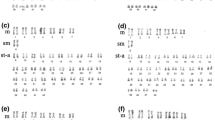Abstract
A satellite DNA sequence of Parodon hilarii (named pPh2004) was isolated, cloned and sequenced. This satellite DNA is composed of 200 bp, 60% AT rich. In situ hybridization (FISH) results revealed that the satellite DNA pPh2004 is located in the terminal regions of several chromosomes, forming highly evident blocks in some and punctual marks in others. The comparison between the FISH and C-banding results showed that the location of this satellite DNA coincides with that of most terminal heterochromatins. However, some regions are only marked by FISH whereas other regions are only marked by C-banding. The possible existence of more than one satellite DNA family could explain these partial differences. The in situ hybridization with the satellite DNA and the G- and C-bandings confirmed the presence of a sex chromosome system of the ZZ/ZW type in P. hilarii, as well as the correct identification of the Z chromosome in the karyotype. This chromosome displays a segment of terminal heterochromatin in the long arm, similar to the segment observed in the short arm of the W chromosome, also showing a G-banding pattern similar to that of the short arm and part of the long arm of the W chromosome. A hypothesis on the origin of the W chromosome from an ancestral chromosome similar to the Z chromosome is presented.
Similar content being viewed by others
References
Bertollo, L.A.C., C.S. Takahashi & O. Moreira-Filho, 1978. Cytotaxonomic considerations on Hoplias lacerdae (Pisces, Erythrynidae). Braz. J. Genet. 1: 103–120.
Bertollo, L.A.C., M.S. Fontes, A.S. Fenocchio & J. Cano, 1997. The X1X2Y sex chromosome system in the fish Hoplias malabaricus. I. G, C and chromosome replication banding. Chromosome Res. 5: 493–499.
Cano, J., A. Pretel, S. Melendez, F. Garcia, V. Caputo, A.S. Fenocchio & L.A.C. Bertollo, 1996. Determination of early stages of sex chromosome differentiation in the sea bass Dicentrarchus labrax L. (Pisces: Perciformes). Cytobios 87: 45–59.
Centofante, L., L.A.C. Bertollo & O. Moreira-Filho, 2002. A ZZ/ZW sex chromosome system in a new species of the genus Parodon (Pisces, Parodontidae). Caryologia 55(2): 139–150.
Charlesworth, B., P. Sniegowski & S. Wolfgang, 1994. The evolutionary dynamics of repetitive DNA in eukaryotes. Nature 371: 215–220.
Devlin, R.H., G.W. Stone & D.E. Smailus, 1998. Extensive directtandem organization of a long repeat DNA sequence on the Y chromosome of chinook salmon (Oncorhynchus tshawytscha). J. Mol. Evol. 46: 277–287.
Franck, J.P.C., A.S. Harris, P. Bentzen, E.M.D. Wright & J.M Wright, 1991. Organization and Evolution of Satellite, Minisatellite and Microsatellite DNAs in Teleost Fishes. Oxford Surveys on Eukaryotic Genes, Vol. 7. Oxford University Press.
Galetti Jr., P.M. & F. Foresti, 1986. Evolution of the ZZ/ZWsystem in Leporinus (Pisces, Anostomidae). Cytogenet. Cell Genet. 43: 43–46.
Garrido-Ramos, M.A., M. Jamilena, R. Lozano, C.R. Rejón & M.R. Rejón, 1994. Cloning and characterization of a fish centromeric satellite DNA. Cytogenet. Cell Genet. 65: 233–237.
Haaf, T., M. Schmid, C. Steinlein, P.M. Galetti Jr. & H.F. Willard, 1993. Organization and molecular cytogenetics of a satellite DNA family from Hoplias malabaricus (Pisces, Erythrinidae). Chromosome Res. 1: 77–86.
Jesus, C.M., L.A.C. Bertollo & O. Moreira-Filho, 1999. Comparative cytogenetics in Apareiodon affinis (Pisces, Characiformes) and considerations regarding diversification of the group. Genetica 105: 63–67.
Jesus, C.M. & O. Moreira-Filho, 2000. Karyotypes of three species of Parodon (Teleostei: Parodontidae). Ichthyol. Explor. Freshwaters 11(1): 75–80.
Koehler, M.R., T. Haaf, M. Guttenbach, M. Schartl & M. Schmid, 1997. Cytogenetics of the genus Leporinus (Pisces, Anostomidae). II. Molecular cytogenetics, organization and evolutionary conservation of a chromosome-specific satellite DNA from Leporinus obtusidens. Chromosome Res. 5: 325–331.
Moran, P., J.L. Martinez, E. Garcia-Vasquez & A.M. Pendas, 1996. Sex chromosome linkage of 5S rDNA in rainbow trout (Oncorhynchus mykiss). Cytogenet. Cell Genet. 75: 145–150.
Moreira-Filho, O., L.A.C. Bertollo & P.M. Galetti Jr., 1980. Evidences for a multiple sex chromosome system with female heterogamety in Apareiodon affinis (Pisces, Parodontidae). Caryologia 33(1): 83–91.
Moreira-Filho, O., L.A.C. Bertollo & P.M. Galetti Jr., 1993. Distribution of sex chromosome mechanisms in neotropical fish and description of a ZZ/ZW system in Parodon hilarii (Parodontidae). Caryologia 46(2–3): 115–125.
Nakayama, I., F. Foresti, R. Tewari, M. Schartl & D. Chourrout, 1994. Sex chromosome polymorphism and heterogametic males revealed by two cloned DNA probe in the ZW/ZZ fish Leporinus elongatus. Chromosoma 103: 31–39.
Nanda, I., W. Feichtinger, M. Schmid, J.H. Schröder, H. Zischler & J.T. Epplen, 1990. Simple repetitive sequences are associated with differentiation of the sex chromosomes in the guppy fish. J. Mol. Evol. 30: 456–462.
Oliveira, C. & F. Foresti, 1994. Revisão dos estudos citogenéticos em peixes neotropicais de águas continentais. Proc. IV Simp. Citogenet. Evol. Aplic. de Peixes Neotropicais, Botucatu, SP, Brazil, p. 6.
Oliveira, C. & J.M. Wright, 1998. Molecular cytogenetics analysis of heterochromatin in the chromosomes of tilapia, Oreochromis niloticus (Teleostei: Cichlidae). Chromosome Res. 6: 205–211.
Reed, K.M. & R.B. Phillips, 1995. Molecular characterization and cytogenetic analysis of highly repeated DNAs of lake trout, Salvelinus namaycush. Chromosoma 104: 242–251.
Sambrook, J., E.F. Fritsch & T. Maniatis, 1989. Molecular Cloning. A Laboratory Manual. Cold Spring Harbor Laboratory Press, Cold Spring Harbor, NY.
Sanger, F., S. Nicklen & A.R. Coulson, 1977. DNA sequencing with chain-terminating inhibitors. P. Natl. Acad. Sci USA 74: 5463–5467.
Stephan, W. & S. Cho, 1994. Possible role of natural selection in the formation of tandem-repetitive noncoding DNA. Genetics 136: 333–341.
Sumner, A.T., 1972. A simple technique for demonstrating centromeric heterochromatin. Expl. Cell Res. 75: 304–306.
Weiler, K.S. & B.T. Wakimoto, 1995. Heterochromatin and gene expression in Drosophila. Annu. Rev. Genet. 29: 577–605.
Author information
Authors and Affiliations
Rights and permissions
About this article
Cite this article
Vicente, V.E., Bertollo, L.A.C., Valentini, S.R. et al. Origin and Differentiation of a Sex Chromosome System in Parodon hilarii (Pisces, Parodontidae). Satellite DNA, G- and C-banding. Genetica 119, 115–120 (2003). https://doi.org/10.1023/A:1026082904672
Issue Date:
DOI: https://doi.org/10.1023/A:1026082904672




